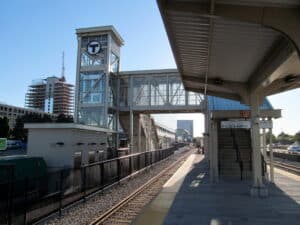
Encouraging dense, transit-oriented developments can help control housing prices and increase vibrancy of nearby commercial districts. Completion of the MBTA’s Boston Landing commuter rail station in 2017 created a new multifamily and life science development cluster in Brighton. Photo by Pi.1415926535 | CC BY-SA 3.0
Density can be a polarizing term. For some, it conjures visions of skyscrapers with people crowded into small apartments. It is even weaponized to drum up fear that multifamily housing is damaging to a community and its residents. Just recently, a couple of Massachusetts communities used arguments like this to justify their non-compliance with the state’s new multifamily zoning law for MBTA communities.
Yet, density is just a measurement. Each piece of land has a density we can measure, and there are variations in the form of development that can achieve the same residential density on the same piece of land in very different ways.
In this way, density can be looked at as an important tool for crafting the types of places we enjoy. Diverse housing options at a range of prices create a more socioeconomically diverse community. Denser neighborhoods often have more variation in the size and form of homes, meeting a broader range of needs.
Having more homes and more multifamily units can improve affordability, too, especially when paired with subsidies and income-restrictions. Plus, other neighborhood features become easier to support. To have a successful village center, Main Street or bustling downtown, we need a commensurate level of housing density to complement commercial and other uses.
If density has these benefits, then underutilized space – especially in places served by transit – represents a missed opportunity to establish great neighborhoods with high levels of mobility, reduced climate impacts and the mix of uses that cultivate a vibrant public realm.
This is not how we’ve planned for housing development in the past, resulting in a settlement pattern that is often at odds with good transportation and climate outcomes. As a result of these dwelling patterns, most households in Massachusetts are reliant on private automobiles.
Archaic Transit System Overdue for Update
This car-dependence has consequences. We dedicate an enormous amount of space to roads and parking, which reduces the amount of space we have for more housing, public parks, commercial uses and public transit. Additionally, cars are a major source of pollution, often most intensely in lower-income neighborhoods through which highways have been built. We also make it less safe to walk, bike and participate in street life when drivers dominate our roads.
Simply locating more housing near transit is not enough to generate a healthy, active, connected community. We must build connections between housing and the rest of the built environment that begin to subvert the prevailing “cars first” mentality. Shared-streets strategies that prioritize non-car road users while limiting space for cars and reducing vehicle speeds are important for reducing traffic injuries and promoting a vibrant neighborhood.

Tom Hopper
While we’ve subsidized car infrastructure, we have short-changed public transportation. This has resulted in low levels of reliability and poor regional transit options. It is not news that our transit system is in poor condition, and we must provide more frequent and reliable service. But we need to do more than just catch transit up to the present. We need to transition from an archaic commuter rail concept to a modern regional rail framework. This is critical to expanding our travel options.
The state must begin to work in a different and more coordinated way to make progress on our housing, transportation and climate goals. There is enormous potential to recalibrate these relationships under the banner of land use planning, especially as MBTA communities begin to comply with the new multifamily zoning requirement. We must seize this opportunity to create the conditions near transit that facilitate a better future for Massachusetts neighborhoods and their residents.
Tom Hopper is the director of research and analytics at MHP’s Center for Housing Data and chief creator of Residensity.






